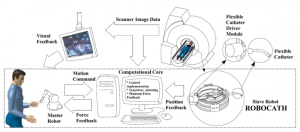Medical interventions under beating heart conditions through a transapical approach offer advantages over traditional procedures, such as faster patient recovery time.
A team of University of Houston researchers proposed the design of a robotic platform, named ROBOCATH, to address issues of the restricted space inside the magnetic resonance imaging (MRI) which fit the requirements of sophisticated and minimally invasive interventions. Equipped with MRI as the image modality, ROBOCATH is capable of positioning and orienting a cardiac catheter, while avoiding collision between the interventional tool and the internal organs under beating heart conditions.
Operational needs, such as MRI-compatibility, chest relative motion compensation, accuracy and compactness are addressed in the design of the platform.
Co-principal investigators Karolos Grigoriadis of the University of Houston Department of Mechanical Engineering and Javad Mohammadpour of the University of Georgia led Ph.D. mechanical engineering candidates Amirhossein Salimi and Amin Ramezanifar in the development of the robotic system.
The team first completed a comprehensive study on the influence of blood flow on the catheter in such an intervention to determine the forces and disturbances affecting the procedure, and began designing a robotic platform that acts as an interface between surgeon and patient during the intervention.
ROBOCATH is able to manipulate flexible catheters to access the aorta, according to the operator’s commands. Mounting the platform on the patient allows the system to cope with relative chest motion and keeps it compact.
The main concern in the design of ROBOCATH was MRI-compatibility. No metallic parts or electronic devices, including an actuator or sensor, are allowed within the sensitive area of the scanner. To this point, the robot platform was built with a 3D printer using acrylonitrile butadiene styrene (ABS), a plastic material.
The challenge of the selection of an MRI-compatible actuation system was met by employing cost-efficient, conventional electric motors placed far from the sensitive area.
A cable transmission system transfers the generated torque to the robot's joints. An additional contribution of this study is the design and implementation of an advanced, model-based controller to obtain the desired performance of the robot in tracking set points and reference trajectories. Experimental results demonstrate that the proposed control scheme successfully accomplishes these goals.
The researchers are currently conducting additional experiments to combine existing platform capabilities with an imaging modality unit such that the ROBOCATH could autonomously track beating heart environments while simultaneously following operator commands.
This project is supported by the National Science Foundation.
